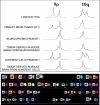Genetic alterations and in vivo tumorigenicity of neurospheres derived from an adult glioblastoma
- PMID: 15469606
- PMCID: PMC524518
- DOI: 10.1186/1476-4598-3-25
Genetic alterations and in vivo tumorigenicity of neurospheres derived from an adult glioblastoma
Abstract
Pediatric brain tumors may originate from cells endowed with neural stem/precursor cell properties, growing in vitro as neurospheres. We have found that these cells can also be present in adult brain tumors and form highly infiltrating gliomas in the brain of immunodeficient mice. Neurospheres were grown from three adult brain tumors and two pediatric gliomas. Differentiation of the neurospheres from one adult glioblastoma decreased nestin expression and increased that of glial and neuronal markers. Loss of heterozygosity of 10q and 9p was present in the original glioblastoma, in the neurospheres and in tumors grown into mice, suggesting that PTEN and CDKN2A alterations are key genetic events in tumor initiating cells with neural precursor properties.
Figures


References
-
- Singh SK, Clarke ID, Terasaki M, Bonn VE, Hawkins C, Squire J, Dirks PB. Identification of a cancer stem cell in human brain tumors. Cancer Res. 2003;63:5821–5828. - PubMed
-
- Li J, Yen C, Liaw D, Podsypanina K, Bose S, Wang SI, Puc J, Miliaresis C, Rodgers L, McCombie R, Bigner SH, Giovanella BC, Ittmann M, Tycko B, Hibshoosh H, Wigler MH, Parsons R. PTEN, a putative protein tyrosine phosphatase gene mutated in human brain, breast, and prostate cancer. Science. 1997;275:1943–1947. doi: 10.1126/science.275.5308.1943. - DOI - PubMed
Publication types
MeSH terms
LinkOut - more resources
Full Text Sources
Other Literature Sources
Medical
Research Materials
Miscellaneous

